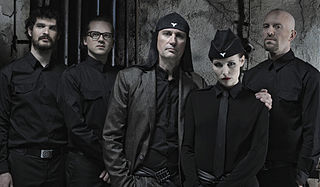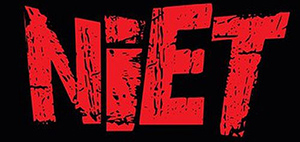Rock and roll is a musical genre from the United States, popularized worldwide beginning in the 1950s. Though rock had become popular earlier, it was not until the mid-1980s breakthrough of Laibach, who are now internationally renowned, that Slovenian rock became well-known. Other well-known Slovenian rock bands include Hic et Nunc, whose 1998 tour of the United States brought even more international attention to Slovenian rock.
In Yugoslavia, Slovenia was the center for punk rock. The best-known representatives of this genre were Pankrti, Niet, Lublanski Psi, Čao Pičke, Via Ofenziva, Tožibabe, and Otroci Socializma.
Popular rock artists, largely unknown outside the country, are: Lačni Franz (Zoran Predin), Šank Rock, Big Foot Mama, Zaklonišče Prepeva, Siddharta, Vlado Kreslin, Niet, Mi2, Buldožer, Carpe Diem, Dan D, Društvo mrtvih pesnikov, Elvis Jackson (ska punk), Orlek, Avtomobili, Pink Panker, Joker Out and others.
Slovenian neofolk/martial industrial band Laibach are also sometimes mentioned as the most known Slovenian "rock" band.
Rock is a broad genre of popular music that originated as "rock and roll" in the United States in the late 1940s and early 1950s, developing into a range of different styles from the mid-1960s, particularly in the United States and the United Kingdom. It has its roots in 1940s and 1950s rock and roll, a style that drew directly from the blues and rhythm and blues genres of African-American music and from country music. Rock also drew strongly from genres such as electric blues and folk, and incorporated influences from jazz and other musical styles. For instrumentation, rock has centered on the electric guitar, usually as part of a rock group with electric bass guitar, drums, and one or more singers. Usually, rock is song-based music with a 4
4 time signature using a verse–chorus form, but the genre has become extremely diverse. Like pop music, lyrics often stress romantic love but also address a wide variety of other themes that are frequently social or political. Rock was the most popular genre of music in the U.S. and much of the Western world from the 1950s to the 2010s.

Laibach is a Slovenian and Yugoslav avant-garde music group associated with the industrial, martial, and neo-classical genres. Formed in the mining town of Trbovlje in 1980, Laibach represents the musical wing of the Neue Slowenische Kunst (NSK) collective, a group which Laibach helped found in 1984.
Industrial music is a genre of music that draws on harsh, mechanical, transgressive or provocative sounds and themes. AllMusic defines industrial music as the "most abrasive and aggressive fusion of rock and electronic music" that was "initially a blend of avant-garde electronics experiments and punk provocation". The term was coined in the mid-1970s with the founding of Industrial Records by members of Throbbing Gristle and Monte Cazazza. While the genre name originated with Throbbing Gristle's emergence in the United Kingdom, artists and labels vital to the genre also emerged in the United States and other countries.
In the minds of many foreigners, Slovenian folk music means a form of polka that is still popular today, especially among expatriates and their descendants. However, there are many styles of Slovenian folk music beyond polka and waltz. Kolo, lender, štajeriš, mafrine and šaltin are a few of the traditional music styles and dances.
Popular music of the United Kingdom in the 1970s built upon the new forms of music developed from blues rock towards the end of the 1960s, including folk rock and psychedelic rock movements. Several important and influential subgenres were created in Britain in this period, by pursuing the limitations of rock music, including British folk rock and glam rock, a process that reached its apogee in the development of progressive rock and one of the most enduring subgenres in heavy metal music. Britain also began to be increasingly influenced by third world music, including Jamaican and Indian music, resulting in new music scenes and subgenres. In the middle years of the decade the influence of the pub rock and American punk rock movements led to the British intensification of punk, which swept away much of the existing landscape of popular music, replacing it with much more diverse new wave and post punk bands who mixed different forms of music and influences to dominate rock and pop music into the 1980s.

British rock describes a wide variety of forms of music made in the United Kingdom. Since around 1964, with the "British Invasion" of the United States spearheaded by the Beatles, British rock music has had a considerable impact on the development of American music and rock music across the world.
Balkan music is a type of music found in the Balkan region of southeastern Europe. The music is characterised by complex rhythm. Famous bands in Balkan music include Taraf de Haïdouks, Fanfare Ciocărlia, and No Smoking Orchestra.
Rock music in Bosnia and Herzegovina mostly developed during the time when the country was part of socialist Yugoslavia.
Music of Kosovo is music that originates from Kosovo, a country in the Balkans. Kosovo's population is mainly Kosovo Albanians, also known as Kosovars, and there are various minority ethnic groups as well. Kosovan music is closely related to that of neighbouring Albania, as well as to that of countries in the former Yugoslavia.

Niet is a punk rock and hardcore punk band from Ljubljana, Slovenia. They were one of the most iconic and influential music groups of the Slovenian punk movement and the punk rock in Yugoslavia in general. The band was active from 1983 to 1988, from 1993 to 1994 and 2008 to 2017 and is active again since December 2019.
New wave in Yugoslavia was the new wave music scene of the Socialist Federal Republic of Yugoslavia. As its counterparts, the British and the American new wave, from which the main influences came, the Yugoslav scene was also closely related to punk rock, ska, reggae, 2 tone, power pop and mod revival. Some of its acts are also counted as belonging to the Yugoslav punk scene which already existed prior to new wave. Such artists were labeled as both punk rock and new wave.

The history of the punk subculture involves the history of punk rock, the history of various punk ideologies, punk fashion, punk visual art, punk literature, dance, and punk film. Since emerging in the United States, the United Kingdom and Australia in the mid-1970s, the punk subculture has spread around the globe and evolved into a number of different forms. The history of punk plays an important part in the history of subcultures in the 20th century.
Punk rock in Yugoslavia was the punk subculture of the former Socialist Federal Republic of Yugoslavia. The most developed scenes across the federation existed in the Socialist Republic of Slovenia, the Adriatic coast of the Socialist Republic of Croatia, the Socialist Autonomous Province of Vojvodina and Belgrade, the capital of both Yugoslavia and the Socialist Republic of Serbia. Some notable acts included: Pankrti, Paraf, Pekinška patka, KUD Idijoti, Niet, Patareni and KBO!.

The music of Yugoslavia refers to music created during the existence of Yugoslavia, spanning the period between 1918 and 1992. The most significant music scene developed in the later period of the Socialist Federal Republic of Yugoslavia, and includes internationally acclaimed artists such as: the alternative music acts Laibach and Disciplina Kičme which appeared on MTV; classical music artists such as Ivo Pogorelić and Stefan Milenković; folk artists such as the Roma music performer Esma Redžepova; the musicians of the YU Rock Misija contribution to Bob Geldof's Band Aid; the Eurovision Song Contest performers such as the 1989 winners Riva and Tereza Kesovija, who represented Monaco at the Eurovision Song Contest 1966 and her own country in 1972, and plenty of others.
Popular music in Yugoslavia includes the pop and rock music of the former SFR Yugoslavia, including all their genres and subgenres. The scene included the constituent republics: SR Slovenia, SR Croatia, SR Bosnia and Herzegovina, SR Montenegro, SR Macedonia and SR Serbia and its subunits: SAP Vojvodina and SAP Kosovo. The pop and rock scene was a part of the general Music of Yugoslavia, which also included folk, classical music, jazz etc. Within Yugoslavia and internationally, the phrases ex-YU or ex-Yugoslav Pop and Rock both formally and informally generally to the SFRY period, though in some cases also to its successor the FR Yugoslavia including Serbia and Montenegro which existed until 2006.

Slovene culture is the culture of the Slovenes, a south Slavic ethnic group. It is incredibly diverse for the country's small size, spanning the southern portion of Central Europe, being the melting pot of Slavic, Germanic and Romance cultures while encompassing parts of the Eastern Alps, the Pannonian Basin, the Balkan Peninsula and the Mediterranean.
Novi Rock was a widely acclaimed rock festival in Ljubljana, Slovenia, which brought the latest currents in popular music to Slovene and Yugoslav audiences between 1981 and 2000. Igor Bašin wrote the book about the festival in 2006. The book takes an analytical look at the festival in the wider social context of the final decade of Yugoslavia and the first decade of independent Slovenia.
Igor Vidmar is a prominent Slovenian and former Yugoslav journalist, rock music promoter and manager, music producer and political activist.
Druga godba is a world music festival organized yearly in Ljubljana, Slovenia.





